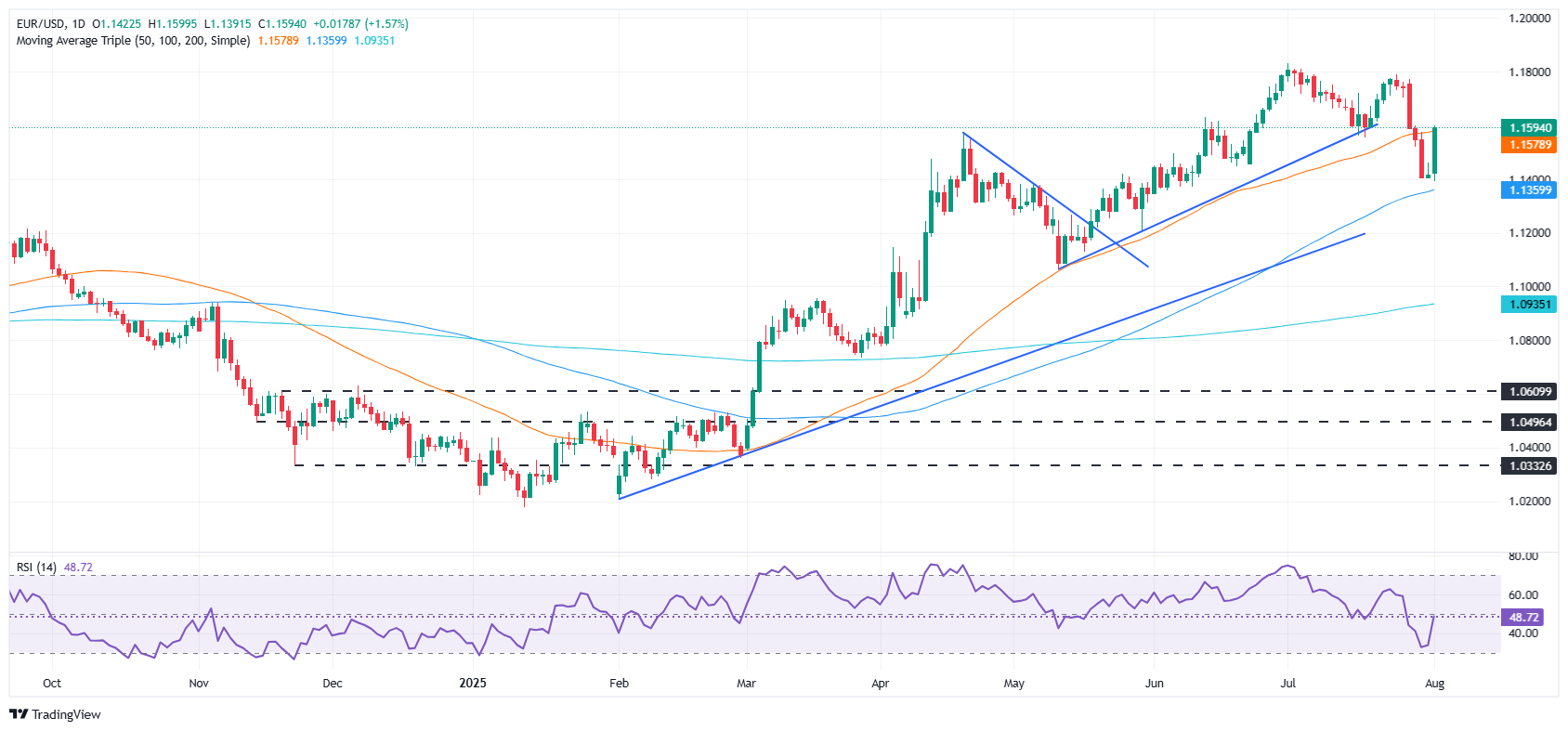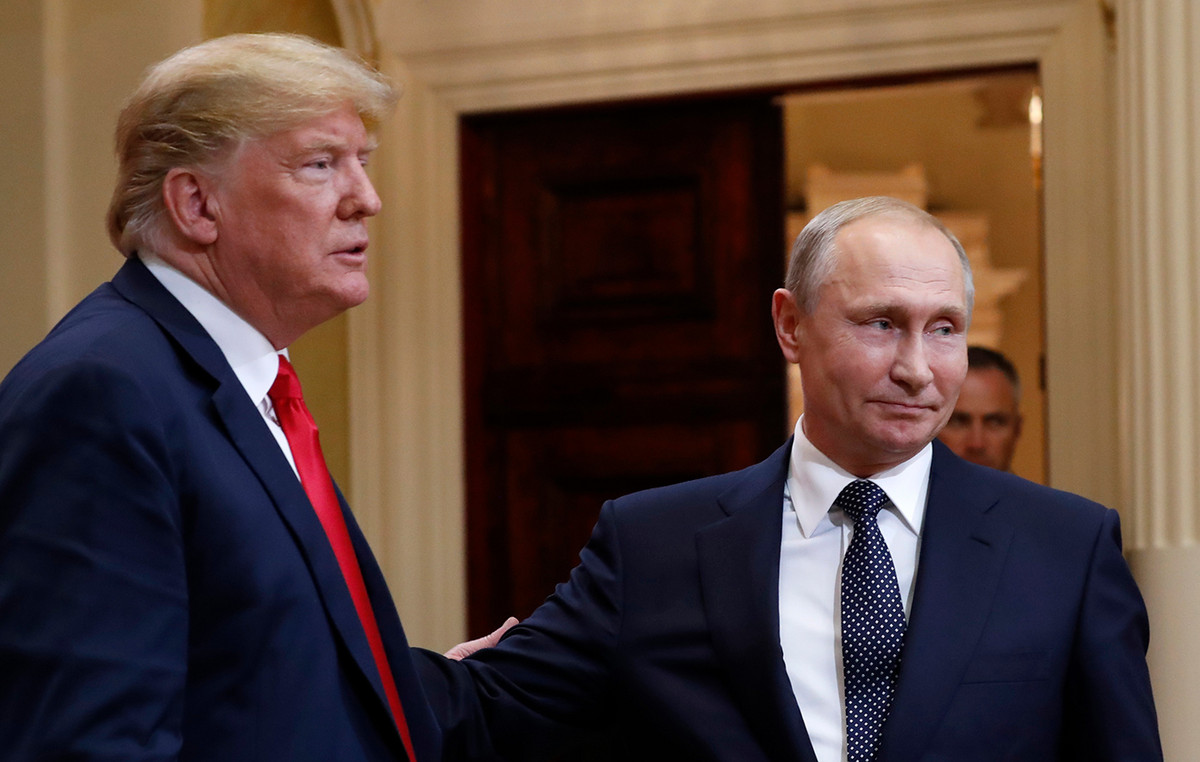- EUR/USD rises from 1,1391 to 1,1554, winning more than 1% on Friday.
- Julio’s non -agricultural payroll show only 73K added jobs; May and June reviews cut 258k jobs.
- Fed funds discount 62 basic relief points for December; 76% probabilities of a rate cut in September.
- EU inflation data exceeds forecasts: IAPC in 2.4% year -on -year, IAPC Setable underlying in 2.0%.
The EUR/USD shoots more than 1% on Friday while the dollar is beaten by an employment report in the United States (USA) worse than expected, which caused the reaction of investors to discount two cuts of interest rates by the Federal Reserve (Fed). The data on the other side of the Atlantic were ignored by the operators, which sent to the pair from minimum of 1,1391 to 1,1597.
Wall Street expanded its losses in the midst of fears of an economic deceleration in the US. The non -agricultural payroll figures (NFP) were expected to be weaker compared to those of June, but the downward revisions of the previous two months, together with the figure last month, promoted the EUR/USD up.
Along with this, the Supply Management Institute (ISM) revealed that manufacturing activity was contracted. Meanwhile, the feeling of the consumer of the University of Michigan (UOM) in June deteriorated, closing a bad day of economic reports for the US economy.
After the NFP, the operators rushed to discount rates cuts by the Fed. Before the announcement, investors waited 34 basic relief points. At the time of writing, the FED Rate Contract of December 2025 in the CBOT shows almost 62 basic points of relief towards the end of the year.
The probabilities of a rate cut of 25 basic points by the Fed at the September meeting are 76%, according to Prime Market Terminal data.
On the other side of the Atlantic, the harmonized index of consumer prices (IAPC) of the European Union remained unchanged by 2.4% interannual, challenging the expectations of a slight fall to 2.3%. The underlying IAPC remained stable at 2.0%, slightly above the 1.9%prognosis, suggesting that underlying inflationary pressures remain firm.
What moves the market today: the euro jumps to the general weakness of the US dollar
- The US non -agricultural payroll increased by only 73K in July, a strong deceleration with respect to June 147k and well below the expected 110k. The unemployment rate rose to 4.2% from 4.1%, in line with forecasts. Meanwhile, average average earnings increased by 3.9% year -on -year, from 3.7% in June and slightly above the 3.8% expected, indicating persistent salary pressure despite the weakness in hiring.
- After the last round of economic data, the Fed parade began. The president of Cleveland’s Fed, Beth Hammack, described the report of non -agricultural payrolls of July as “disappointing”, but said that the labor market is still generally balanced. He added that he remains “confident in the decision taken earlier this week” to keep the stable rates.
- Meanwhile, the president of the Fed of Atlanta, Raphael Bostic, acknowledged that the labor market is slowing down from previously strong levels. He emphasized that inflationary risks are still more pressing than concerns about employment and reiterated their support for only a feature of fees, maintaining a tough line general position.
- The ISM manufacturing PMI fell to 48.0 in July from 49.0, marking the fifth consecutive month of contraction after two brief months of expansion that followed a prolonged decrease of 26 months. The reading did not meet the expectations of 49.5. Notably, the employment subscript was further contracted, while the paid price component indicated a decrease in cost pressures.
- Meanwhile, the feeling of the consumer improved for the second consecutive month, although slightly below the preliminary estimate, going down to 61.7 from 61.8. Inflation expectations were reviewed up for the perspective at 1 year to 4.5% (from 4.4%), while the 5 -year perspective fell to 3.4% from 3.6%, which suggests that homes remain cautiously optimistic about long -term price stability.
- Other data in the EU revealed that the preliminary PMI of Hcob manufacturing in the EU improved for the entire block, Spain and Italy, the latter being the one that remains in contraction territory. On the contrary, Germany and France sank even more in negative territory.
Technical Perspective: The EUR/Usd uploads above 1,1600, with the bulls pointing at 1,1650
The formation of a “morning star” candle pattern indicates that the EUR/USD could resume its upward trend, but will face a key resistance in 1,1600. The Relative Force Index (RSI) bounced from almost overene territory, closing near its neutral line. That said, a cross above 50 would confirm that buyers are in command.
If the EUR/USD exceeds the simple mobile average (SMA) of 20 days in 1,1645, a movement towards 1,1700 is in the cards. With greater force, the next key resistance will be 1,1800 and the maximum of the year to date (YTD) in 1,1830.
On the contrary, a fall below the 50 -day SMA in 1,1576 would clear the road to 1,1550, subsequently followed by the figure of 1,1500. The next area of interest would be the minimum of August 1,1391.

EURO – FREQUENT QUESTIONS
The euro is the currency of the 19 countries of the European Union that belong to the Eurozone. It is the second most negotiated currency in the world, behind the US dollar. In 2022, it represented 31 % of all foreign exchange transactions, with an average daily business volume of more than 2.2 billion dollars a day. The EUR/USD is the most negotiated currency pair in the world, with an estimate of 30 %of all transactions, followed by the EUR/JPY (4 %), the EUR/GBP (3 %) and the EUR/AU (2 %).
The European Central Bank (ECB), based in Frankfurt (Germany), is the Eurozone reserve bank. The ECB establishes interest rates and manages monetary policy. The main mandate of the ECB is to maintain price stability, which means controlling inflation or stimulating growth. Its main tool is the rise or decrease in interest rates. Relatively high interest rates (or the expectation of higher types) usually benefit the euro and vice versa. The GOVERNMENT BOOK of the ECB makes decisions about monetary policy in meetings that are held eight times a year. The decisions are made by the directors of the National Banks of the Eurozone and six permanent members, including the president of the ECB, Christine Lagarde.
Eurozone inflation data, measured by the harmonized consumer prices index (IPCA), are an important economic indicator for the euro. If inflation increases more than expected, especially if it exceeds 2% of the ECB, it forces the ECB to rise interest rates to control it again. Relatively high interest rates compared to their counterparts usually benefit the euro, since they make the region more attractive as a place for global investors to deposit their money.
Published data measure the health of the economy and can have an impact on the euro. Indicators such as GDP, manufacturing and services PMIs, employment and consumer trust surveys can influence the direction of the single currency. A strong economy is good for the euro. Not only attracts more foreign investment, but it can encourage the ECB to raise interest rates, which will directly strengthen the euro. Otherwise, if economic data is weak, the euro is likely to fall. The economic data of the four largest economies in the euro zone (Germany, France, Italy and Spain) are especially significant, since they represent 75% of the economy of the euro area.
Another important fact that is published on the euro is the commercial balance. This indicator measures the difference between what a country earns with its exports and what you spend on imports during a given period. If a country produces highly demanded export products, its currency will gain value simply by the additional demand created by foreign buyers seeking to buy those goods. Therefore, a positive net trade balance strengthens a currency and vice versa in the case of a negative balance
Source: Fx Street
I am Joshua Winder, a senior-level journalist and editor at World Stock Market. I specialize in covering news related to the stock market and economic trends. With more than 8 years of experience in this field, I have become an expert in financial reporting.







